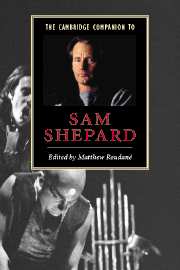Book contents
- Frontmatter
- Introduction
- 1 Born injured
- 2 Shepard and Off-Off-Broadway
- 3 Shepard on Shepard
- 4 A note on Sam Shepard
- 5 Joseph Chaikin and Sam Shepard in collaboration
- 6 Repetition and regression in Curse of the Starving Class and Buried Child
- 7 Shepard writes about writing
- 8 Reflections of the past in True West and A Lie of the Mind
- 9 Patriarchal pathology from The Holy Ghostly to Silent Tongue
- 10 The classic Western and Sam Shepard’s family sagas
- 11 European textures
- 12 Sam Shepard and the cinema
- 13 Sam Shepard as musical experimenter
- 14 Sam Shepard’s nondramatic works
- 15 States of Shock, Simpatico, and Eyes for Consuela
- 16 Sam Shepard’s The Late Henry Moss
- 17 Sam Shepard
- Select bibliography
- Index
6 - Repetition and regression in Curse of the Starving Class and Buried Child
Published online by Cambridge University Press: 28 May 2006
- Frontmatter
- Introduction
- 1 Born injured
- 2 Shepard and Off-Off-Broadway
- 3 Shepard on Shepard
- 4 A note on Sam Shepard
- 5 Joseph Chaikin and Sam Shepard in collaboration
- 6 Repetition and regression in Curse of the Starving Class and Buried Child
- 7 Shepard writes about writing
- 8 Reflections of the past in True West and A Lie of the Mind
- 9 Patriarchal pathology from The Holy Ghostly to Silent Tongue
- 10 The classic Western and Sam Shepard’s family sagas
- 11 European textures
- 12 Sam Shepard and the cinema
- 13 Sam Shepard as musical experimenter
- 14 Sam Shepard’s nondramatic works
- 15 States of Shock, Simpatico, and Eyes for Consuela
- 16 Sam Shepard’s The Late Henry Moss
- 17 Sam Shepard
- Select bibliography
- Index
Summary
In a 1988 interview, Sam Shepard commented on the centrality of the notion of family and heredity to his thought: “What doesn't have to do with family? There isn't anything, you know what I mean? Even a love story has to do with family. Crime has to do with family. We all come out of each other - everyone is born out of a mother and a father, and you go on to be a father. It's an endless cycle.” Whether critics consider Curse of the Starving Class (1977) and Buried Child (1978) the first two parts of a “family trilogy” completed by True West (1980), or the first two movements in a quintet - those three works plus Fool for Love (1983) and A Lie of the Mind (1985) - they all agree that these two plays mark a turning point to a more realistic, perhaps somewhat O'Neillian dramaturgy. Yet, as Charles R. Lyons insists, it is a realism to which Shepard attaches his own original signature by ironically undercutting it: “Shepard took up another highly conventionalized aesthetic form - dramatic realism - and reconfigured its typical structure to accommodate the more open, fluid conventions of his writing . . . this shift forms another 'appropriation': Shepard's borrowing of the conventions of dramatic realism, theatrical schemes which, by this point, were also 'popular' although decidedly not ideologically radical.”
- Type
- Chapter
- Information
- The Cambridge Companion to Sam Shepard , pp. 111 - 122Publisher: Cambridge University PressPrint publication year: 2002
- 2
- Cited by



